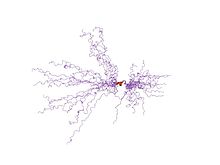Calmodulin binding domain
| CaMBD | |||||||||
|---|---|---|---|---|---|---|---|---|---|
 solution structure of the calmodulin binding domain (cambd) of small conductanceCa2+-activated potassium channels (sk2) | |||||||||
| Identifiers | |||||||||
| Symbol | CaMBD | ||||||||
| Pfam | PF02888 | ||||||||
| InterPro | IPR004178 | ||||||||
| SCOP2 | 1kkd / SCOPe / SUPFAM | ||||||||
| |||||||||
In molecular biology, calmodulin binding domain (CaMBD) is a protein domain found in small-conductance calcium-activated potassium channels (SK channels). These channels are independent of voltage and gated solely by intracellular Ca2+. They are heteromeric complexes that comprise pore-forming alpha-subunits and the Ca2+-binding protein calmodulin (CaM).[1] CaM binds to the SK channel through the CaMBD, which is located in an intracellular region of the alpha-subunit immediately carboxy-terminal to the pore. Channel opening is triggered when Ca2+ binds the EF hands in the N-lobe of CaM. The structure of this domain complexed with CaM is known.[1] This domain forms an elongated dimer with a CaM molecule bound at each end; each CaM wraps around three alpha-helices, two from one CaMBD subunit and one from the other.
References
- ^ a b Schumacher MA, Rivard AF, Bachinger HP, Adelman JP (April 2001). "Structure of the gating domain of a Ca2+-activated K+ channel complexed with Ca2+/calmodulin". Nature. 410 (6832): 1120–4. Bibcode:2001Natur.410.1120S. doi:10.1038/35074145. PMID 11323678. S2CID 205016620.
